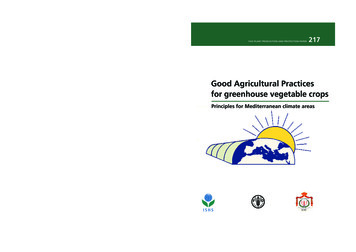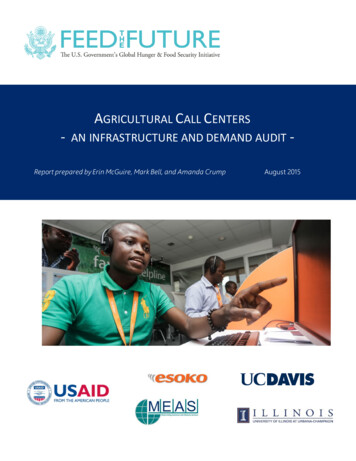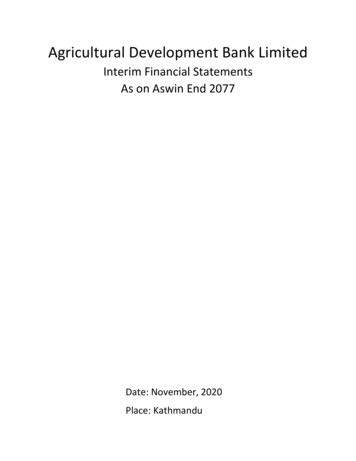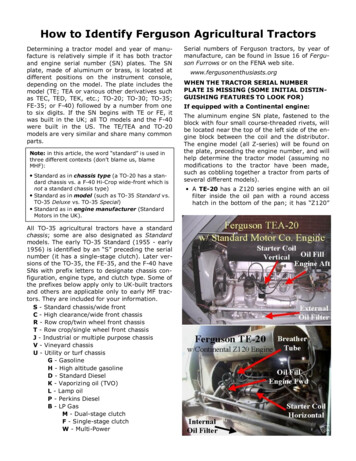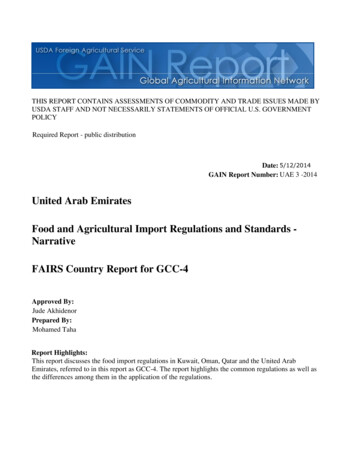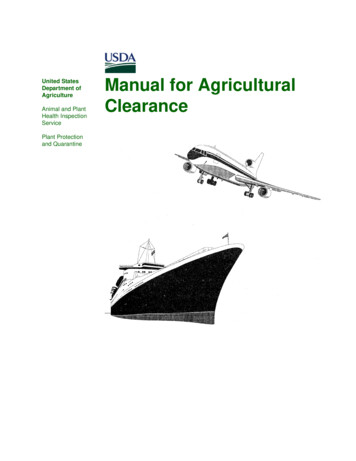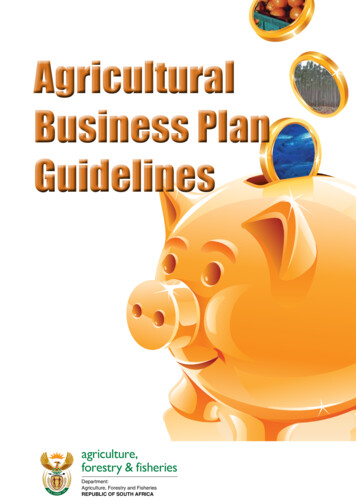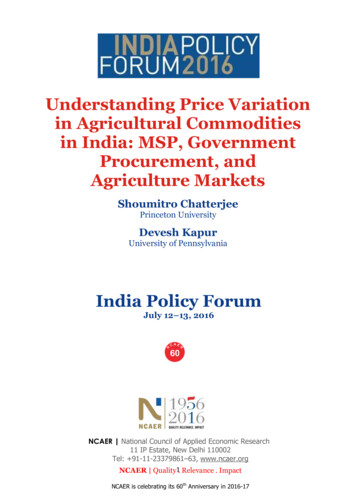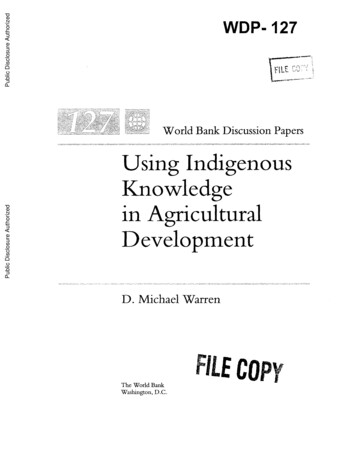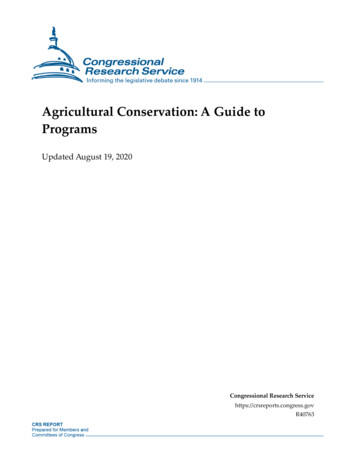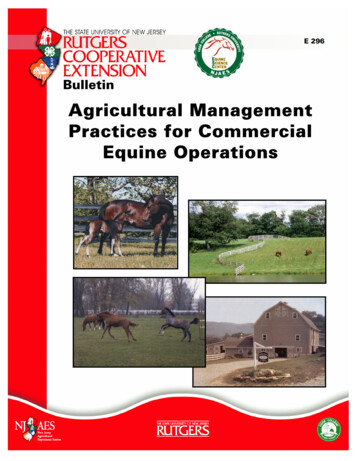
Transcription
E 296BulletinAgricultural ManagementPractices for CommercialEquine Operations
AUTHORSDonna L. Foulk, Program Associate, Rutgers Cooperative Extension of Warren CountyRobert C. Mickel, County Agricultural Agent, Rutgers Cooperative Extension ofHunterdon CountyEverett A. Chamberlain, County Agricultural Agent, Rutgers Cooperative Extension ofWarren CountyMarjorie Margentino, Program Associate, Rutgers Cooperative ExtensionMichael Westendorf, Specialist in Livestock and Dairy, Rutgers Cooperative ExtensionThe authors wish to thank the following Committee members for their technical assistance:William Bamka, County Agricultural Agent, Rutgers Cooperative Extension ofBurlington CountyBruce Barbour, Environmental Program Leader, Rutgers Cooperative ExtensionAndrew Borisuk, Sussex County Agriculture Development BoardSusan Craft, Burlington County Farmland Preservation ProgramStephen P. Dey, State Board of Agriculture, NJ Equine Advisory BoardWilliam Fox, Ocean County Agriculture Development BoardMarci Green, State Agriculture Development CommitteeMary Jo Herbert, Mercer County Agriculture Development BoardGeorge D. Jones, District Conservationist, USDA Natural Resource Conservation ServiceDave Kimmel, State Agriculture Development CommitteeDaniel Kluchinski, Chair, Department of Agriculture and Resource Management Agents,Rutgers Cooperative ExtensionUta Krogmann, Specialist in Solid Waste Management, Rutgers Cooperative ExtensionKaryn Malinowski, Director, Equine Science Center, and Director of Rutgers CooperativeExtensionLynn Mathews, NJ Equine Advisory Board, NJ Department of AgricultureSarah Ralston, Associate Professor in Animal Science, Rutgers Cooperative ExtensionGregory Romano, NJ Department of AgricultureWilliam Sciarappa, County Agricultural Agent, Rutgers Cooperative Extension of MonmouthCountyCarey Williams, Specialist in Equine Management, Rutgers Cooperative Extension1
Table of ContentsPageINTRODUCTION .3SECTION I.FARM STOCKING RATES .4Pasture Regime .4Drylot Regime.5No Regular Turnout Regime.5SECTION II.PASTURE MANAGEMENT .6Importance of Pastures and Hay .6Pasture Stocking Rates.6Rotational Grazing .6Soil Testing and Pasture Nutrients .7Mowing.7Pasture Species.7Weed Management .8Renovation .9Poisonous Plants and Trees in Pastures.9SECTION III.FENCING .10Basics of Effective Fencing .10Types of Fences .10Construction of Fences.10SECTION IV.SHELTER .11SECTION V.MANURE MANAGEMENT .12Nutrient Management on Horse Farms .12Stall Waste Production and Characteristics.12Manure Storage .13Locating Manure Storage Areas and Facilities .14Sizing of Manure Storage Facilities .15Management of Stored Manure.15Spreading Manure .15Manure Disposal .16Composting .17Concentrated Animal Feeding Operations (CAFO) .17Stream Bank Fencing .18SECTION VI.RIDING AND TRAINING AREAS.19Location and Size.19Types of Footing Materials .19Maintenance.20Dust Control.21Dust Control Products.21Water as a Dust Control Agent .22SECTION VII. Traditional Equine Activities and Special Events.23REFERENCES.252
Agricultural Management Practices forCommercial Equine OperationsINTRODUCTIONThe equine industry is a very large and diverse component of New Jersey agriculture. Theindustry supports thousands of jobs, generates nearly 700 million in horse-related expenditures,and provides a variety of recreational opportunities for horse owners and the general public.Over 80,000 acres of land are used for equine-related purposes, providing many thousands ofacres of agricultural open space.The purpose of this document is to establish generally accepted Agricultural ManagementPractices (AMP) for the various equine-related activities that may be associated with theoperation of a commercial farm. These activities include: managing pastures and manure,constructing fences and shelters, determining farm stocking rates, controlling dust, maintainingarenas and training tracks, and organizing horse shows and special events.Throughout this AMP, a horse is defined as a 1,000 pound animal, which is equivalent to oneanimal unit.3
SECTION I. FARM STOCKING RATESSince horses do not require pasture grasses to meet their nutritional needs, higher farm stockingrates can be obtained if pastures are not used as the major factor in determining animal densities.The land size required to maintain a horse is not as critical an issue as the management and useof the animals. Appropriate equine stocking rates will vary with the management practices of thefarm. At increased stocking rates, adopting good farm management practices becomes a higherpriority. Manure management plans must be strictly adhered to as stocking rates increase. Higheranimal densities can be attained if horses are confined to stalls or drylots for a large portion ofthe day. More specific information on animal waste management can be obtained in the manuremanagement section of this AMP.For the purpose of establishing guidelines for farm stocking rates, farms will be considered tofall into one of three management regimes: Farms which use pastures as an important component of nutrition and exercise Farms which use drylots for turnout and exercise rather than pastures Farms which use riding, driving, and training programs as a source of exercisewith no regular turnout providedEach regime allows for increased levels of animal densities and requires different managementstrategies as described below:Pasture RegimeIf pastures are used on the farm to provide a significant source of nutrition and exercise, animaldensities that would maintain at least 70% vegetative cover in the pastures should be established.The following recommendations can serve as guidelines for establishing stocking rates, based onrestricting the number of horses and time allowed for turnout in order to maintain 70% or highervegetative cover in the pastures: One horse can be maintained on one-half acre of pasture, if turnout time islimited to fewer than three hours per day. One horse can be maintained on one acre of pasture, if turnout time islimited to three to eight hours per day. One horse can be maintained on one and one-half acre of pasture, ifturnout time is limited to eight to twelve hours per day. One horse can be maintained on two or more acres of pasture withunlimited turnout time.The stocking rates listed above can be increased with elevated levels of management. Mowing,irrigating, fertilizing, overseeding, and rotating pastures can allow higher animal densities whilestill maintaining at least 70% vegetative cover.4
Drylot RegimeHigher animal densities can be obtained on a farm if drylots are used for turnout. Drylots havelittle or no vegetation. The primary function of a drylot is exercise. If horses are maintained indrylots, care must be taken to segregate the horses in cases where individual horses or groups ofhorses are not compatible.Drylots should be well-drained so the animals are not standing in mud. Drylots are frequentlyconstructed with a stone base and covered with natural clay or crushed stone. Measures mayneed to be in place to control erosion of stone, soil, and manure into areas that will impact waterquality. These measures may include diversions, filters, and buffer areas as described in theNRCS Field Office Technical Guide.The following recommendations can serve as guidelines for establishing stocking rates andmanure management practices for drylot turnout, where vegetation has been reduced to less than70%: If the overall farm density is fewer than three horses per drylot acre and the drylotvegetation is maintained between 50% and 70%, then manure should be removedfrom deposition areas at least once a month. Manure may need to be removedmore frequently during peak fly breeding periods, which occur when temperaturesexceed 65 degrees, and if odor and runoff become an issue. The farm shouldcomply with all nutrient management and manure storage guidelines as referencedby the NRCS Field Office Technical Guide. If the overall farm density is three or more horses per drylot acre, manure shouldbe removed from deposition areas on a weekly basis. The farm should complywith all nutrient management and manure storage guidelines as referenced by theNRCS Field Office Technical Guide.No Regular Turnout RegimeIn some instances, commercial equine operations may choose not to turn horses out on a regularbasis. Since movement is important to proper digestive function and overall horse health, horsesthat are kept primarily in stalls should be afforded the opportunity to exercise and/or be part of ariding, driving, or training program. Horses in intense training, such as show or race horses, andhorses in lesson programs may not receive regular turnout. In these commercial agricultural farmsettings, which are continuous and intensive, it is difficult to set restrictions on equine numbers.The farm should comply with all nutrient management and manure storage regulations asreferenced by the NRCS Field Office Technical Guide.5
SECTION II. PASTURE MANAGEMENTImportance of Pastures and HayDue to differences in age, size, genetics, health, and use, horses vary greatly in the amount offeed needed to maintain body condition. Generally, horses will need to consume 1.5% to 3% oftheir body weight in feed per day. Although there are many ways of meeting a horse’s nutritionalrequirements, it is recommended that a horse receive 70% to 100% of the feed as pasture and/orhay. Grain-based concentrates can be used as needed to compliment the forage in the diet.Although pastures are not necessary in meeting a horse’s forage needs, pastures offer manyadvantages. Grazing reduces the amount of hay that is necessary, helps distribute manure in thefield, allows horses access to exercise that is necessary for proper function of the digestivesystem, provides opportunities for equine social interaction, and provides an aestheticallypleasing environment for rural and residential neighbors.Pasture Stocking RatesAs a general rule, pasture quality can easily be maintained at stocking rates of two or more acresper horse with limited management. Higher stocking rates can be obtained by limiting the timethat horses are allowed to graze and by rotating grazing pastures.Stocking rates for pastures change as the seasons and weather conditions change. Cool seasonpasture grasses produce tremendous growth in spring and fall, and very little growth during hot,dry summers. Pastures that can support three 1,000-pound horses (three animal units) per acre inthe spring when the pasture grasses are actively growing may only support one-half of a horseper acre in summer. Stocking rates depend on the yield potential of the forages, hours of turnout,and level of management (rest, rotation, mowing, fertilization, and weed control). Pasture useand turnout time should be varied to match pasture growth.The following information should serve only as a guideline for maintaining and improvingpastures. Appropriate pasture management strategies vary from farm to farm, and need tobe determined on an individual basis.Rotational GrazingResting pastures are very important in maintaining healthy plants. Horses tend to feed on grassesin the same area, and can eventually weaken and kill the plants. It is very beneficial to removehorses from the pasture when the short grass species (bluegrass and ryegrass) fall below 1-2inches, and the tall grass species (timothy, orchardgrass, tall fescue, and brome) fall below 3inches. Horses can be returned to the pasture when the short grass has recovered to 5-6 inchesand the tall grass is about 7 inches in height. Removing horses from pastures allows the grasstime to produce more leaf tissue and regenerate carbohydrate reserves in the roots. The length oftime a pasture needs to rest depends on how fast the grasses are growing. The height of the grassitself will dictate the resting period.Most farm managers do not have enough land to practice intensive rotational grazing. However,just splitting an existing paddock and rotating the horses between the two new pastures can create6
dramatic improvement in productivity. Regularly restricting horses to dry lots or stalls and limitingturnout time on pastures is another available option. Pastures can be adequately maintained atstocking rates of 1–2 acres per horse, if the pastures are rotated and/or grazing time is restricted.Soil Testing and Pasture NutrientsProperly applying fertilizers to pastures is a critical component of pasture management.Nitrogen, phosphorous, potassium and pH levels can vary greatly. The only way to accuratelydetermine the soil nutrient needs of a pasture is to conduct a soil test. Soil test kits and directionson collecting soil samples for analysis are available at all local Rutgers Cooperative Extensionoffices. The analysis report will document soil pH and fertility levels, and will provide lime andfertilizer recommendations. Applying fertilizer and lime based on soil test recommendations willresult in maximum forage production, and provides economic and environmental benefits inpreventing the application of unnecessary soil nutrients. Nitrogen (N) promotes the maximumgrowth of cool season grasses in pastures. An adequate supply of nitrogen is associated withvigorous vegetative growth and a plant’s dark green color. Reduced plant growth and a palegreen or yellow color characterize nitrogen deficiency. Adequate phosphorous (P) insures greatercrop quality, greater stem strength, increased root growth, and earlier crop maturity. Potassium(K) deficiency is characterized by reduced plant growth, poor stalk strength, reduced diseaseresistance, and reduced winter hardiness.MowingMowing is a major component of pasture management. Mowing helps remove many weeds andprevents them from going to seed. It is also very important in maintaining a grass stand that isuniform in maturity. Horses tend to eat the shortest grass, because it is tender and higher inprotein. Mowing helps promote a higher quality pasture. Shorter grass species, such as bluegrassand rye grass, should be mowed at 2-3 inches; taller grass species should be mowed at 4-5inches.Pasture SpeciesMost pasture seed mixes contain a large variety of species. It is expected that several of thespecies in the mix will thrive in a particular pasture. Pastures should be seeded with a pasturemix and not seed mixtures designed for lawn. Many cultivars of turf fescue and rye grassescontain endophytes, which have been bred into the species to enhance survival. The endophytesproduce a toxin which is detrimental to grazing animals. When selecting a seed mixture, speciesshould be chosen that match the particular site, farm goals, and management practices.Bluegrass will grow only in cool weather and goes dormant during the summer. However, it cansurvive heavy grazing pressure and trampling, and can form a thick sod. Although no grassesgrow well in the heat of summer, tall fescue grows better during warm weather than other coolseason grasses. It may not be as palatable, but provides some summer forage if conditions areright. Only endophyte-free varieties of fescue should be seeded for pasture use. Timothy,brome, and orchardgrass are tall grasses that are ideal for pastures. Orchardgrass, inparticular, responds well to nitrogen applications. Although timothy and brome are high qualityforages, they will not tolerate heavy grazing, and should not be seeded if grazing pressure ishigh. Reed canarygrass grows well under wet conditions, but matures quickly and is notpalatable when mature. Clover can be used in small quantities, if desired. Clover is beneficial,7
since it adds nitrogen to the soil. However, clover can harbor a fungus which causes horses tosalivate when grazing on it.The chart below is a summary of cool season grass characteristics:LegumeSeedlingVigorKentucky bluegrassOrchardgrassPerennial ryegr
Uta Krogmann, Specialist in Solid Waste Management, Rutgers Cooperative Extension Karyn Malinowski, Director, Equine Science Center, and Director of Rutgers Cooperative . The purpose of this document is to establish generally accepted Agricultural Management Practices (AMP) for the various
